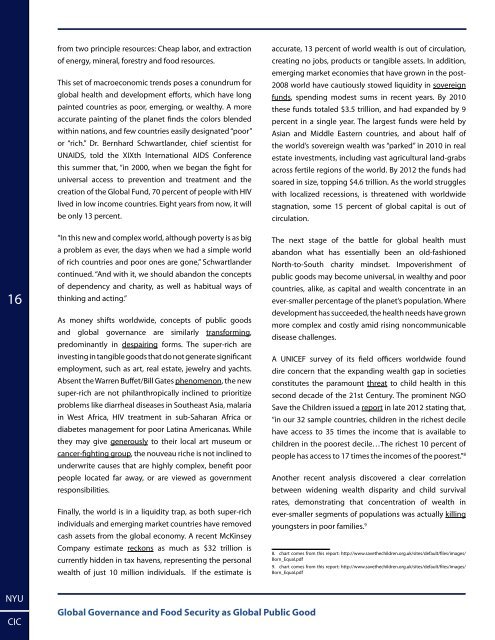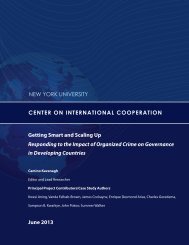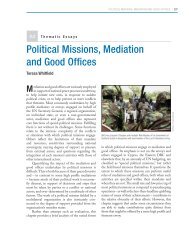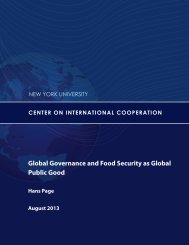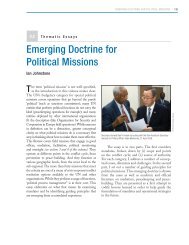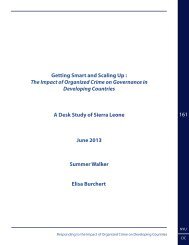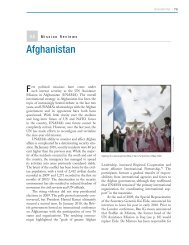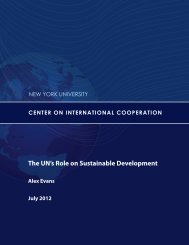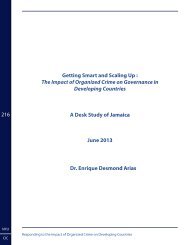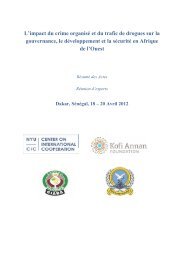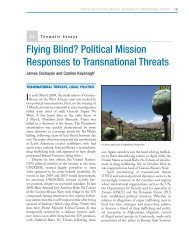Existential Challenges to Global Health - Center on International ...
Existential Challenges to Global Health - Center on International ...
Existential Challenges to Global Health - Center on International ...
You also want an ePaper? Increase the reach of your titles
YUMPU automatically turns print PDFs into web optimized ePapers that Google loves.
16<br />
from two principle resources: Cheap labor, and extracti<strong>on</strong><br />
of energy, mineral, forestry and food resources.<br />
This set of macroec<strong>on</strong>omic trends poses a c<strong>on</strong>undrum for<br />
global health and development efforts, which have l<strong>on</strong>g<br />
painted countries as poor, emerging, or wealthy. A more<br />
accurate painting of the planet finds the colors blended<br />
within nati<strong>on</strong>s, and few countries easily designated “poor”<br />
or “rich.” Dr. Bernhard Schwartlander, chief scientist for<br />
UNAIDS, <str<strong>on</strong>g>to</str<strong>on</strong>g>ld the XIXth Internati<strong>on</strong>al AIDS C<strong>on</strong>ference<br />
this summer that, “in 2000, when we began the fight for<br />
universal access <str<strong>on</strong>g>to</str<strong>on</strong>g> preventi<strong>on</strong> and treatment and the<br />
creati<strong>on</strong> of the <str<strong>on</strong>g>Global</str<strong>on</strong>g> Fund, 70 percent of people with HIV<br />
lived in low income countries. Eight years from now, it will<br />
be <strong>on</strong>ly 13 percent.<br />
“In this new and complex world, although poverty is as big<br />
a problem as ever, the days when we had a simple world<br />
of rich countries and poor <strong>on</strong>es are g<strong>on</strong>e,” Schwartlander<br />
c<strong>on</strong>tinued. “And with it, we should aband<strong>on</strong> the c<strong>on</strong>cepts<br />
of dependency and charity, as well as habitual ways of<br />
thinking and acting.”<br />
As m<strong>on</strong>ey shifts worldwide, c<strong>on</strong>cepts of public goods<br />
and global governance are similarly transforming,<br />
predominantly in despairing forms. The super-rich are<br />
investing in tangible goods that do not generate significant<br />
employment, such as art, real estate, jewelry and yachts.<br />
Absent the Warren Buffet/Bill Gates phenomen<strong>on</strong>, the new<br />
super-rich are not philanthropically inclined <str<strong>on</strong>g>to</str<strong>on</strong>g> prioritize<br />
problems like diarrheal diseases in Southeast Asia, malaria<br />
in West Africa, HIV treatment in sub-Saharan Africa or<br />
diabetes management for poor Latina Americanas. While<br />
they may give generously <str<strong>on</strong>g>to</str<strong>on</strong>g> their local art museum or<br />
cancer-fighting group, the nouveau riche is not inclined <str<strong>on</strong>g>to</str<strong>on</strong>g><br />
underwrite causes that are highly complex, benefit poor<br />
people located far away, or are viewed as government<br />
resp<strong>on</strong>sibilities.<br />
Finally, the world is in a liquidity trap, as both super-rich<br />
individuals and emerging market countries have removed<br />
cash assets from the global ec<strong>on</strong>omy. A recent McKinsey<br />
Company estimate reck<strong>on</strong>s as much as $32 trilli<strong>on</strong> is<br />
currently hidden in tax havens, representing the pers<strong>on</strong>al<br />
wealth of just 10 milli<strong>on</strong> individuals. If the estimate is<br />
accurate, 13 percent of world wealth is out of circulati<strong>on</strong>,<br />
creating no jobs, products or tangible assets. In additi<strong>on</strong>,<br />
emerging market ec<strong>on</strong>omies that have grown in the post-<br />
2008 world have cautiously s<str<strong>on</strong>g>to</str<strong>on</strong>g>wed liquidity in sovereign<br />
funds, spending modest sums in recent years. By 2010<br />
these funds <str<strong>on</strong>g>to</str<strong>on</strong>g>taled $3.5 trilli<strong>on</strong>, and had expanded by 9<br />
percent in a single year. The largest funds were held by<br />
Asian and Middle Eastern countries, and about half of<br />
the world’s sovereign wealth was “parked” in 2010 in real<br />
estate investments, including vast agricultural land-grabs<br />
across fertile regi<strong>on</strong>s of the world. By 2012 the funds had<br />
soared in size, <str<strong>on</strong>g>to</str<strong>on</strong>g>pping $4.6 trilli<strong>on</strong>. As the world struggles<br />
with localized recessi<strong>on</strong>s, is threatened with worldwide<br />
stagnati<strong>on</strong>, some 15 percent of global capital is out of<br />
circulati<strong>on</strong>.<br />
The next stage of the battle for global health must<br />
aband<strong>on</strong> what has essentially been an old-fashi<strong>on</strong>ed<br />
North-<str<strong>on</strong>g>to</str<strong>on</strong>g>-South charity mindset. Impoverishment of<br />
public goods may become universal, in wealthy and poor<br />
countries, alike, as capital and wealth c<strong>on</strong>centrate in an<br />
ever-smaller percentage of the planet’s populati<strong>on</strong>. Where<br />
development has succeeded, the health needs have grown<br />
more complex and costly amid rising n<strong>on</strong>communicable<br />
disease challenges.<br />
A UNICEF survey of its field officers worldwide found<br />
dire c<strong>on</strong>cern that the expanding wealth gap in societies<br />
c<strong>on</strong>stitutes the paramount threat <str<strong>on</strong>g>to</str<strong>on</strong>g> child health in this<br />
sec<strong>on</strong>d decade of the 21st Century. The prominent NGO<br />
Save the Children issued a report in late 2012 stating that,<br />
“in our 32 sample countries, children in the richest decile<br />
have access <str<strong>on</strong>g>to</str<strong>on</strong>g> 35 times the income that is available <str<strong>on</strong>g>to</str<strong>on</strong>g><br />
children in the poorest decile…The richest 10 percent of<br />
people has access <str<strong>on</strong>g>to</str<strong>on</strong>g> 17 times the incomes of the poorest.” 8<br />
Another recent analysis discovered a clear correlati<strong>on</strong><br />
between widening wealth disparity and child survival<br />
rates, dem<strong>on</strong>strating that c<strong>on</strong>centrati<strong>on</strong> of wealth in<br />
ever-smaller segments of populati<strong>on</strong>s was actually killing<br />
youngsters in poor families. 9<br />
8. chart comes from this report: http://www.savethechildren.org.uk/sites/default/files/images/<br />
Born_Equal.pdf<br />
9. chart comes from this report: http://www.savethechildren.org.uk/sites/default/files/images/<br />
Born_Equal.pdf<br />
NYU<br />
CIC<br />
<str<strong>on</strong>g>Global</str<strong>on</strong>g> Governance and Food Security as <str<strong>on</strong>g>Global</str<strong>on</strong>g> Public Good


